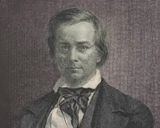
In the spring of 1849, the newly founded Smithsonian Institution purchased its first collection, a group of European prints and art books assembled by Vermont Congressman George Perkins Marsh. The prints were praised as “translations . . . of the best creations of genius in painting and sculpture,” and although unrelated to the Smithsonian’s then primarily scientific orientation, they were viewed as a comprehensive way to satisfy the Congressional mandate for an art gallery that was part of the original legislation which established the Smithsonian Institution in 1846.
Acquisition of the Marsh Collection was decidedly premature. The Smithsonian Institution Building, now familiarly known as The Castle, was still under construction, and the collection did not have a proper home until the completion of the West Wing in 1850 when the prints and books were placed in the library. Librarian Charles Coffin Jewett regarded them as the best examples available because he was not optimistic about the prospects for acquiring paintings and sculpture of a comparable caliber. As Jewett explained in the 1850 Smithsonian Institution Annual Report, “Engraving seems to be the only branch of the fine arts, which we can, for the present, cultivate. One good picture or statue would cost more than a large collection of prints . . . It can hardly be doubted, that, in no way, could this Institution, for the present do so much for every department of the fine arts, without injury to other objects of its care, as by procuring a collection of engravings, so full and so well chosen as that which now adorns its Library.”
The Smithsonian demonstrated remarkable prescience in acquiring the Marsh Collection, but it also displayed a good deal of uncertainty about what to do with it. As it was the first public print collection in the nation, there was no established precedent to serve as a reference. The Smithsonian’s developing scientific agenda did not easily accommodate the visual arts, so the collection was not exhibited but remained part of the library.
After a devastating fire in 1865 damaged parts of The Castle, Secretary Joseph Henry sent the Smithsonian’s library, including the Marsh Collection, to the Library of Congress to form the Smithsonian Deposit. In 1874 Henry loaned several dozen remaining prints to the new Corcoran Gallery of Art. By the early 1880s the Smithsonian’s second secretary, Spencer Fullerton Baird, realized the collection’s potential for the expanded U. S. National Museum that was taking shape in what is now known as the Arts and Industries Building. Baird and his assistant secretary, George Brown Goode, began to recall the prints and books, and more than four hundred of Marsh’s prints were retrieved during the 1880s and 1890s for use in exhibitions. Today some of the Marsh Collection remains at the Library of Congress, and staff members from both institutions are working cooperatively to identify and describe the contents of this remarkable collection.
National Museum of American History Graphic Arts Curator Helena E. Wright's 2015 book, The First Smithsonian Collection: the European Engravings of George Perkins Marsh and the Role of Prints in the U.S. National Museum, recounts the complex history of the Smithsonian’s Marsh Collection. This website provides catalog information for Marsh’s books and prints held at the Smithsonian. Additions will be posted to the site as the identification process proceeds.
A note about numbering: Although the Marsh Collection was acquired in 1849, it was not accessioned at the time. In 1978 a group of Marsh prints was accessioned, and we are now using that number for additional cataloging.
Our collection database is a work in progress. We may update this record based on further research and review. Learn more about our approach to sharing our collection online.
If you would like to know how you can use content on this page, see the Smithsonian's Terms of Use. If you need to request an image for publication or other use, please visit Rights and Reproductions.